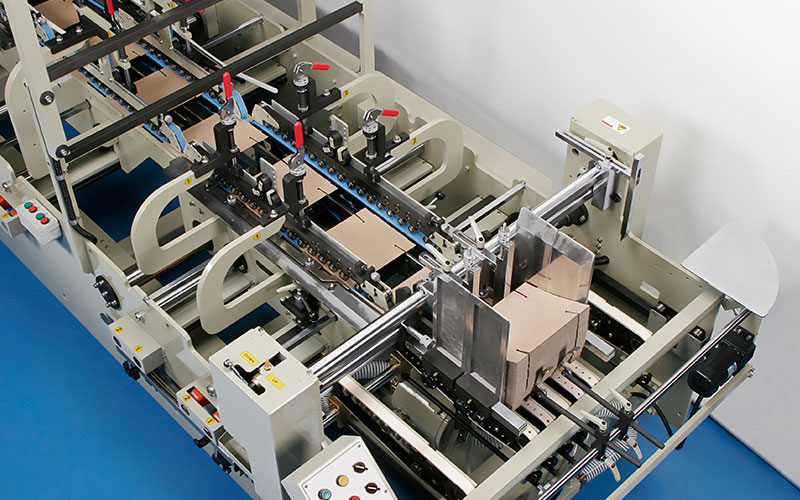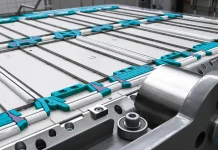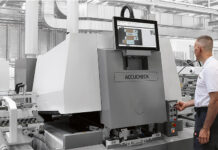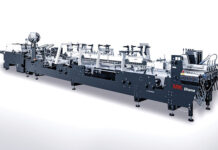By Kevin Koplin, managing director, and Shawn Rogers, training manager, American International Machinery
Those in the industry know that print runs for most everything have become shorter, including many applications for folding cartons. Today, carton runs have been affected by companies having the ability to digitally print short-run cartons as well – meaning carton runs for many applications are becoming shorter and shorter.
No matter how short or long a run for a folding carton project is, in most cases, it must go on a folder-gluer before the final packaging of the product. The folding/gluing process can be meticulous and time consuming, so any type of pre-planning and preparation before the carton reaches the machine is extremely important. PostPress reached out to Kevin Koplin and Shawn Rogers from American International Machinery and asked them to share some tips for working with smaller carton runs, including how to keep makereadies and set-up times to a minimum.
What recommendations would you make to the designer of a folding carton with a niche-market and shorter-run product?
We would highly recommend that the designer discuss the project with the company that is doing the folding/gluing of the carton prior to production. Even better, if an experienced operator can be involved before the final design, on-press challenges can be avoided. Often, operators can determine what issues may arise and how to solve them before running the cartons, potentially saving set-up and running time, as well as decreasing product waste.
From a carton design standpoint, what can help keep folder-gluer costs down when working with shorter runs?
When designing the carton, it is important to use quality materials, such as paper stock and glue. Additionally, preventative maintenance performed at regular intervals on the folder-gluer and experienced or well-trained operators also are keys to success and keeping costs low. For example, if there is a glue issue on a carton, an experienced operator may explain that taking 1/32″ off the edge of the glue flap will eliminate the carton adhesion problem in the future.
Another easy suggestion for times when a coating or varnish is being used is to ask the designer and printer to “knock out” the coating on the glue flap area, eliminating any potential problems where the glue might not adhere to the coated flap. Sometimes, simple adjustments to the design or final printing can save a great deal of time on the folder-gluer.
When working with shorter carton runs, how can operators decrease set-up times and decrease overall time on the folder-gluer?
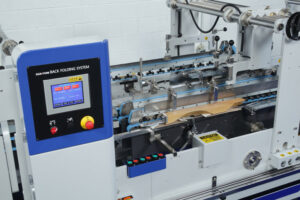
Decreasing makeready times can be approached in many ways. One is to “gang” together jobs that are using a common style of carton set-up. For instance, if there are several jobs of straight-line cartons, running those one right after another will cut down on changeover time because of the similar tooling. Second, it can be a time saver to keep much of the tooling on the machine during changeovers to avoid extra steps when in makeready.
Third, and extremely important, is standardization. Standardizing a carton to the machine will decrease makeready times substantially. This means measuring carrier positions, tooling positions and any other movable/removable parts that are used in the makeready process. There are many different measuring methods for saving this information. Some machines have dial indicators for each carrier to allow the operator to log its location in a database or on a sheet of paper. If all of this information is computerized on the folder-gluer, then it is stored for the operator. Creating a job folder is great for repeat orders for the job history. Following the recorded measuring methods and information prior to producing the order could eliminate mistakes and certainly can save time on press, which is so important on short-run jobs. Also, photos and videos are good tools. Some operators need it to be visual, and a photo or video can help them remember how a job was set up in the past.
When working with coatings or varnishes, what are some ways to decrease potential challenges on the folder-gluer, which in-turn can keep costs down for the project?
Coating issues in the finishing department mostly are driven by press issues. If the coatings were not properly cured or dried, excess spray powder sometimes is used on the sheets. This can cause plenty of issues on the folder-gluers, such as skipping and other quality issues with the printed and coated sheet. Ensuring cartons are coming off the printing press in quality condition before folding/gluing will save time and product waste.
When possible, coatings are needed to prevent downtime and other unforeseen issues during the gluing process. Many times, cartons will not feed or stack consistently, which will lead to high waste and customer complaints. So, if it is a short-run carton job, coatings are recommended. Many times, the problem can be with the sheets being UV-coated inline vs. offline because the ink doesn’t dry properly or the coating is not cured properly. Again, coating sheets on an off-line coater may be a better choice and help eliminate that problem.
What other challenges do short runs create for the finisher or carton manufacturer when folding/gluing?
The biggest challenge is the turnover time in between projects, with short runs often meaning multiple makereadies in a shift or day. Depending on the level of operator experience, this can either make or break a project in terms of profitability. Machine and job standardization is the key to being successful in high-volume throughput. Being proactive and not reactive will increase productivity and reduce waste and downtime.
What future trends in the marketplace will affect the folding/gluing of cartons?
The three main challenges are personnel, maintenance and training. Many companies are experiencing high turnover rates and an all-around operator shortage in the industry. Lack of qualified personnel can lead to production and process issues.
Preventative maintenance often is put on the back burner as supply and demand are the focus and sometimes overshadow the health of the machine. Simple daily, weekly and monthly equipment checks can save hours or sometimes weeks of downtime should the equipment reach a failure point that could have been avoided. Having a machine go down for weeks while waiting on parts can be detrimental to a business.
Operator training is a must and structured training programs, including refresher training courses, are key to achieving faster makeready times, improved run speeds and quality product – resulting in customer retention and higher profitability.
American International Machinery (AIM) is a second-generation, family-owned business that provides a comprehensive line of products and support services for the paperboard and corrugated converting industry, including new, remanufactured and used equipment. AIM established the Signature Folder Gluers brand as one of the top converting equipment options in the industry, focusing on versatility and affordability for packaging companies. For more information, visit www.aim-inc.net/.
Rotary Diecutting a Popular Option for Short-Run Cartons
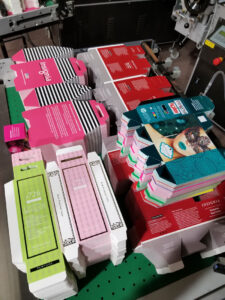 In addition to many changes being made with folding/gluing to accommodate short-run folding cartons, there also is a trend toward using rotary diecutting equipment for short-run work. Rotary diecutting utilizes two magnetic cylinders spinning inward toward one another using a thin flexible die(s) with a metal back to adhere to the cylinder(s) (certain machines use two dies, others just one). When the sheet of cartons travels between the two cylinders, downward pressure is applied via the machine and the cutting blades on the flexible die cuts the sheet on the other side after the rotation is complete.
In addition to many changes being made with folding/gluing to accommodate short-run folding cartons, there also is a trend toward using rotary diecutting equipment for short-run work. Rotary diecutting utilizes two magnetic cylinders spinning inward toward one another using a thin flexible die(s) with a metal back to adhere to the cylinder(s) (certain machines use two dies, others just one). When the sheet of cartons travels between the two cylinders, downward pressure is applied via the machine and the cutting blades on the flexible die cuts the sheet on the other side after the rotation is complete.
One of the biggest advantages of rotary diecutting is changeover time from one job to another. As with folding/gluing, this is extremely important for short-run work to create a suitable profit level on the job. A rotary machine can be changed from one job to the next in as little as 10 minutes, where a more conventional diecutting press can take as long as one hour. Another advantage of rotary diecutting is it provides the operator the ability to create more complex diecutting patterns because the die is CNC engraved vs. the bent steel used on a conventional steel rule die. In addition, flexible dies are much easier to store and can be housed in small filing cabinets, which can help finishers and folding carton manufacturers decrease overall storage space for cutting dies.
There are limitations that must be considered with rotary diecutting as well. The major limitation of the process is with the thickness of the stock/material being diecut. The flexible dies have overall limitations on how far they can cut into the material, where steel rule dies are conventionally two to three inches thick, allowing taller cutting blades to reach through thicker stocks and materials. So, it is important to check the thickness of the carton before considering rotary diecutting as an option.
Folding carton production on rotary systems is ideal for short-runs given the ability to change from one carton skew to another in as little as 10 minutes, which enables companies to justify carton runs as small as 500 sheets. Those sort of runs are difficult to justify on a larger platen press where set-up can be 30 minutes to an hour to run the machine for five to 10 minutes for a 500 to 1,000 sheet job.
This information was provided by Kevin Corwin, product manager for Rollem’s Insignia diecutting line. For more information, visit www.rollemusa.com.

